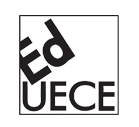Linguística Interacional
DOI:
https://doi.org/10.46230/2674-8266-15-10084Palabras clave:
Linguística Interacional, Análise da Conversa, Sociolinguística InteracionalResumen
O presente capítulo fornece um esboço da Linguística Interacional e sua relevância à Linguística Aplicada. Inclui-se nisso uma pesquisa acerca da emergência da Linguística Interacional, seus conceitos básicos e instrumentos metodológicos, perguntas de pesquisa e desafios futuros da Linguística Interacional, bem como sua contribuição à Linguística Aplicada. O capítulo termina com uma bibliografia de trabalhos citados e referências relevantes.
Descargas
Citas
ANTAKI, C.; LEUDAR, I. Recruiting the record: using opponents’ exact words in parliamentary argumentation. Text & Talk, v. 21, n. 4, p. 467-488, 2001. DOI: https://doi.org/10.1515/text.2001.008
ANTAKI, C.; BARNES, R.; LEUDAR, I. Diagnostic formulations in psychotherapy. Discourse studies, v. 7, n. 6, p. 627-647, 2005. DOI: https://doi.org/10.1177/1461445605055420
ATKINSON, J. M.; DREW, P. Order in court: The Organization of Verbal Interaction in Judicial Settings. London: Palgrave Macmillan, 1979. DOI: https://doi.org/10.1007/978-1-349-04057-5
AUER, P. The pre-front field in spoken German and its relevance as a grammaticalization position. Pragmatics, v. 6, n. 3, p. 295-322, 1996. DOI: https://doi.org/10.1075/prag.6.3.03aue
AUER, P. Online-Syntax - Oder: was es bedeuten könnte, die Zeitlichkeit der mündlichen Sprache ernst zu nehmen. Sprache und Literatur, v. 31, n. 1, p. 43-56, 2000. DOI: https://doi.org/10.30965/25890859-031-01-90000005
AUER, P. Syntax als Prozess. In: HAUSENDORF, H. Gespräch als Prozess. Linguistische Aspekte der Zeitlichkeit verbaler Interaktion. Tübingen: Narr, 2006. p. 95-124.
AUER, P.; GILLES, P.; PETERS, J.; SELTING, M. Intonation regionaler Varietäten des Deutschen. Vorstellung eines Forschungsprojekts. In: STELLMACHER, D. Dialektologie zwischen Tradition und Neuansätzen. Beiträge der Internationalen Dialektologentagung. Göttingen, 19.-21. Oktober 1998 (Zeitschrift für Dialektologie und Linguistik, Beiheft 109. Stuttgart: Steiner.) 2000, p. 222-239.
AUER, P.; DI LUZIO, A. The contextualization of language. Amsterdam/Philadelphia: John Benjamins Publishing, 1992. DOI: https://doi.org/10.1075/pbns.22
AUER, P.; DIRIM, I. Türkisch sprechen nicht nur die Türken. Berlin/New York: de Gruyter, 2012.
BAKER, C.; FIRTH, A.; EMMISON, M. Calling for Help: Language and Social Interaction in Telephone Helplines. Amsterdam/Philadelphia: John Benjamins, 2005. DOI: https://doi.org/10.1075/pbns.143
BARTH-WEINGARTEN, D. Zur (Aus-)Nutzung konzessiver Konstruktionen in Radio Interviews: eine qualitativ-quantitative Untersuchung zur Kontextabhängigkeit von Äußerungen. Gesprächsforschung: Online-Zeitschrift zur verbalen Interaktion, v. 4, p. 251-281, 2003. Disponível em: https://www.gespraechsforschung-ozs.de. Acesso em: 24 ago. 2007.
BARTH-WEINGARTEN, D. Fuzzy boundaries–Überlegungen zu einer Grammatik der gesprochenen Sprache nach konversationsanalytischen Kriterien. In: DEPPERMAN, A.; FIEHLER, R.; SPRANZ-FOGASY; T. Grammatik und Interaktion, Radolfzell: Verlag für Gesprächsforschung, 2006a. p. 67-93. Disponível em: https://www.gespraechsforschung-ozs.de. Acesso em: 24 ago. 2007.
BARTH-WEINGARTEN, D. parallel-opposition-Konstruktionen: Zur Realisierung eines spezifischen Ausdrucks der Kontrastrelation. In: GÜNTHNER, S.; IMO, W. Konstruktionen in der Interaktion. Berlin/New York: Mouton de Gruyter, 2006b. p. 153-179. DOI: https://doi.org/10.1515/9783110894158.153
BECKER-MROTZEK, M.; BRÜNNER, G. Angewandte Gesprächsforschung: Ziele—Methoden-Probleme. In: FIEHLER, R.; SUCHAROWSKI, W. Kommunikationsberatung und Kommunikationstraining: Anwendungsfelder der Diskursforschung. Opladen: Westdeutscher Verlag, 1992. p. 12-23. DOI: https://doi.org/10.1007/978-3-322-85086-7_1
BECKER-MROTZEK, M.; FIEHLER, R. Unternehmenskommunikation. Tübingen: Narr, 2002.
BILMES, J. Question delivery formats as a feature of interactional style in the 1992 vice-presidential debate. Research on Language and Social Interaction, v. 34, p. 151-181, 2001. DOI: https://doi.org/10.1207/S15327973RLSI34-2_1
BIRKNER, K. Subjektive Krankheitstheorien im Gespräch. Gesprächsforschung: Online- Zeitschrift zur verbalen Interaktion, v. 7, p. 152-183, 2006. Disponível em: https://www.gespraechsforschung-ozs.de. Acesso em: 24 aug. 2007.
BOOTH, S.; PERKINS, L. The use of conversation analysis to guide individualized advice to carers and evaluate change in aphasia: a case study. Aphasiology, v. 13, n. 4-5, p. 283-303, 1999. DOI: https://doi.org/10.1080/026870399402109
BRINKER, K.; ANTOS, G.; HEINEMANN, W.; SAGER, S. F. Text-und Gesprächslinguistik/Linguistics of Text and Conversation. Ein internationales Handbuch zeitgenössischer Forschung/An International Handbook of Contemporary Research. Halbband 2: Gesprächslinguistik. Berlin/New York: Mouton de Gruyter, 2001. DOI: https://doi.org/10.1515/9783110169188.2
BRÜNNER, G.; GÜLICH, E. Krankheit verstehen: interdisziplinäre Beiträge zur Sprache in Krankheitsdarstellungen. Bielefeld: Aisthesis, 2002.
BRÜNNER, G.; FIEHLER, R.; KINDT, W. Angewandte Diskursforschung. Opladen: Westdeutscher Verlag, 1999. DOI: https://doi.org/10.1007/978-3-663-07733-6
BYBEE, J. Frequency of use and the organization of language. Oxford: Oxford University Press, 2006. DOI: https://doi.org/10.1093/acprof:oso/9780195301571.001.0001
CLAYMAN, S. Reformulating the question: A device for answering/not answering questions in news interviews and press conferences. Text-Interdisciplinary Journal for the Study of Discourse, v. 13, n. 2, p. 159-188, 1993. DOI: https://doi.org/10.1515/text.1.1993.13.2.159
CLAYMAN, S.; HERITAGE, J. The News Interview: Journalists and Public Figures on the Air. Cambridge: Cambridge University Press, 2002. DOI: https://doi.org/10.1017/CBO9780511613623
CORRIN, J.; TARPLEE, C.; WELLS, B. Interactional linguistics and language development: A conversation ana- lytic perspective on emergent syntax. In: SELTING, Margret; COUPER-KUHLEN, Elizabeth. Studies in interactional linguistics, Amsterdam/Philadelphia: John Benjamins, 2001. p. 199-226. DOI: https://doi.org/10.1075/sidag.10.10cor
COUPER-KUHLEN, E. Prosody and sequence organization in English conversation: The case of a new beginning. In: COUPER-KUHLEN, E.; FORD, C. Sound patterns in interaction. Amsterdam/Philadelphia: John Benjamins, 2004. p. 335-376. DOI: https://doi.org/10.1075/tsl.62.17cou
COUPER-KUHLEN, E.; SELTING, M. Towards an interactional perspective on prosody and a prosodic perspective on interaction. In: SELTING, M.; COUPER-KUHLEN, E. Prosody in conversation: Interactional studies. Cambridge: Cambridge University Press, 1996. p. 11-56. DOI: https://doi.org/10.1017/CBO9780511597862.003
COUPER-KUHLEN, E.; SELTING, M. Introducing interactional linguistics. In: SELTING, M.; COUPER-KUHLEN, E. Studies in interactional linguistics. Amsterdam/Philadelphia: John Benjamins, 2001. p. 1-22 DOI: https://doi.org/10.1075/sidag.10.02cou
COUPER-KUHLEN, E.; THOMPSON, S. You know it's funny: Eine Neubetrachtung der “Extraposition” im Englischen. In: GÜNTHNER, Susanne; IMO, Wolfgang. Konstruktionen in der Interaktion. Berlin/New York: Mouton de Gruyter, 2006, p. 23-58. DOI: https://doi.org/10.1515/9783110894158.23
CROMDAL, J. “Can I be with?” Negotiating play entry in a bilingual school. Journal of pragmatics, v. 33, n. 4, p. 515-543, 2001. DOI: https://doi.org/10.1016/S0378-2166(99)00131-9
CUMMING, S.; ONO, Tsuyoshi. Discourse and grammar. In: VAN DIJK, T. Discourse as Structure and Process. Discourse Studies: A multidisciplinary introduction, London: Sage, v. 1, 1997. p. 112-137. DOI: https://doi.org/10.4135/9781446221884.n4
CZYZEWSKI, M. Mm hm tokens as interactional devices in the psychotherapeutic in-take interview. In: TEN HAVE, P.; PSATHAS, G. Situated order: Studies in the social organization of talk and embodied activities. Washington, D. C.: University Press of America, 1995. p. 73-89
DEPPERMANN, A. Gespräche analysieren. Eine Einführung in konversationsanalytische Methoden. Opladen: Leske und Budrich. 1999.
DEPPERMANN, A. Ethnographische Gesprächsanalyse: Zu Nutzen und Notwendigkeit von Ethnographie für die Konversationsanalyse. Gesprächsforschung: Online-Zeitschrift zur verbalen Interaktion, v. 1, p. 96-124, 2000. Disponível em: https://www.gespraechsforschung-ozs.de. Acesso em: 24 ago. 2007.
DEPPERMANN, A. Disrespecting: A conversational practice for the negotiation of status in juvenile peer-groups. In: NÉMETH, E. Pragmatics in 2000: Selected Papers from the 7th International Pragmatics Conference. Antwerpen: International Pragmatics Association, 2001. p. 156-164.
DEPPERMANN, A. Conversational interpretation of lexical items and conversational contrasting. In: SELTING, M.; HAKULIEN, A. Syntax and lexis in conversation. Studies on the use of linguistic resources in talk-in-interaction. Amsterdam/Philadelphia: John Benjamins, 2005. p. 289-317. DOI: https://doi.org/10.1075/sidag.17.15dep
DEPPERMANN, A. Construction Grammar–eine Grammatik für die Interaktion? In: DEPPERMANN, A.; FIEHER, R.; SPRANZ-FOGASY, T. Grammatik und Interaktion, Radolfzell: Verlag für Gesprächsforschung, 2006. p. 43-65. Disponível em: http://www.verlag-gesprachsforschung.de/2006/deppermann.htm. Acesso em: 15 jun. 2007.
DEPPERMANN, A. Grammatik und Semantik aus gesprächsanalytischer Sicht. In: Grammatik und Semantik aus gesprächsanalytischer Sicht. Berlin/New York: de Gruyter, 2007.
DEPPERMANN, A.; SPRANZ-FOGASY, T. be-deuten. Wie Bedeutung im Gespräch entsteht. Tübingen: Stauffenburg, 2002.
DREW, P. Strategies in the contest between lawyer and witness in cross-examination. In: LEVI, J.; WALKER, A. G. Language in the judicial process. Springer, Boston, MA, 1990. p. 39-64. New York/Washington: Plenum Press, 1990. p. 39-64. DOI: https://doi.org/10.1007/978-1-4899-3719-3_2
DREW, P.; HERITAGE, J. Analyzing talk at work: An introduction. In: DREW, P.; HERITAGE, J. Talk at Work. Cambridge: Cambridge University Press, 1992. p. 3-65.
EERDMANS, S.; PREVIGNANO, C.; THIBAULT, P. Language and interaction: discussions with John J. Gumperz. Amsterdam/Philadelphia: John Benjamins, 2003. DOI: https://doi.org/10.1075/z.117
FIEHLER, R. et al. Eigenschaften gesprochener Sprache. Tübingen: Narr, 2004.
FOLEY, W. Anthropological Linguistics: An Introduction. Oxford: Blackwell, 1997.
FORD, C. Grammar in interaction: Adverbial clauses in American English conversations. Cambridge: Cambridge University Press, 1993. DOI: https://doi.org/10.1017/CBO9780511554278
FORD, C.; FOX, B.; THOMPSON, S. The language of turn and sequence. Oxford: Oxford University Press, 2002.
FORD, C.; THOMPSON, S. Interactional Units in Conversation: Syntactic, Intonational and Pragmatic Resources. In: OCHS, E.; SCHEGLOFF, E.; THOMPSON, S. Interaction and grammar. Cambridge: Cambridge University Press, 1996. p. 134-184. DOI: https://doi.org/10.1017/CBO9780511620874.003
FORD, C.; WAGNER, J. Interaction-based studies of language. Special issue of Pragmatics, v. 6, n. 3, p. 277-456, 1996. DOI: https://doi.org/10.1075/prag.6.3
FOX, B. Discourse structure and anaphora: Written and conversational English. Cambridge: Cambridge University Press, 1987. DOI: https://doi.org/10.1017/CBO9780511627767
FOX, B.; HAYASHI, M.; JASPERSEN, R. Resources and repair: A cross-linguistic study of syntax and repair. In: OCHS, E.; SCHEGLOFF, E.; THOMPSON, S. Interaction and Grammar. Cambridge: Cambridge University Press, 1996. DOI: https://doi.org/10.1017/CBO9780511620874.004
FOX, B.; THOMPSON, S. Relative clauses in English conversation: Relativizers, frequency, and the notion of construction. Studies in Language, v. 31, n. 2, p. 293-326, 2007. DOI: https://doi.org/10.1075/sl.31.2.03fox
FRANKEL, R. From sentence to sequence: Understanding the medical encounter through microinteractional analysis. Discourse processes, v. 7, n. 2, p. 135-170, 1984. DOI: https://doi.org/10.1080/01638538409544587
FRANKEL, R. Talking in interviews: A dispreference for patient-initiated questions in physician-patient encounters. In: PSATHAS, G. Interaction Competence, Washington: University Press of America, v. 1, 1990. p. 231-262.
FRENCH, P.; LOCAL, J. Turn-competitive incomings. Journal of Pragmatics, v. 7, n. 1, p. 17-38, 1983. DOI: https://doi.org/10.1016/0378-2166(83)90147-9
GILL, V. T.; MAYNARD, D. On “labeling” in actual interaction: Delivering and receiving diagnoses of developmental disabilities. Social problems, v. 42, n. 1, p. 11-37, 1995. DOI: https://doi.org/10.1525/sp.1995.42.1.03x0453k
GILLES, P. Regionale Prosodie im Deutschen. Variabilität in der Intonation von Abschluss und Weiterweisung, Berlin/New York: de Gruyter, 2005. DOI: https://doi.org/10.1515/9783110201611
GOODWIN, C. The interactive construction of a sentence in natural conversation. In: PSATHAS, G. Everyday language: Studies in ethnomethodology, New York: Irvington Publishers, v. 97, 1979. p. 101-121.
GOODWIN, C. Conversational Organization: Interaction between Speakers and Hearers. New York: Academic Press, 1981.
GOODWIN, C. Co-constructing meaning in conversations with an aphasie man. Research on language and social interaction, v. 28, n. 3, p. 233-260, 1995. DOI: https://doi.org/10.1207/s15327973rlsi2803_4
GREATBATCH, D. Some standard uses of supplementary questions in news interviews. In: WILSON, J.; CROW, B. Belfast working papers in language and linguistics, Jordanstown: University of Ulster, v. 8, p. 86-123, 1986.
GREATBATCH, D. Aspects of topical organization in news interviews: The use of agenda-shifting procedures by interviewees. Media, Culture & Society, v. 8, n. 4, p. 441-455, 1986. DOI: https://doi.org/10.1177/0163443786008004005
GREATBATCH, D. On the management of disagreement between news interviewees. In: DREW, P.; HERITAGE, J. Talk at Work, 1992. p. 268-301.
GÜLICH, E.; SCHÖNDIENST, M.; SURMANN, V. (eds.). Wie Anfälle zur Sprache kommen. Psychotherapie und Sozialwissenschaft, v. 4, n. 02, p. 235-239. 2002.
GÜNTHNER, S.; IMO, W. Konstruktionen in der Interaktion. Berlin/New York: de Gruyter, 2006. DOI: https://doi.org/10.1515/9783110894158
GÜNTHNER, S.; KNOBLAUCH, H. Culturally patterned speaking practices-the analysis of communicative genres. Pragmatics, v. 5, n. 1, p. 1-32, 1995. DOI: https://doi.org/10.1075/prag.5.1.03gun
GUMPERZ, J. Discourse strategies. Cambridge: Cambridge University Press, 1982. DOI: https://doi.org/10.1017/CBO9780511611834
GUTHRIE, A. On the systematic deployment of okay and mmhmm in academic advising sessions. Pragmatics, v. 7, n. 3, p. 397-415, 1997. DOI: https://doi.org/10.1075/prag.7.3.06gut
HABSCHEID, S. Gesprächsberatung in Organisationen und Institutionen. In: KNAPP, K.; ANTOS, G.; BECKER-MROTZEK, M.; DEPPERMANN, A.; GÖPFERICH; S.; GRABOWSKI, J.; KLEMM, M.; VILLIGER; C. Angewandte Linguistik. Ein Lehrbuch. Tübingen/Basel: Francke, 2004. p. 320-340.
HAKULINEN, A.; SELTING, M. Syntax and Lexis in Conversation. Studies on the Use of Linguistic Resources in Talk-in-interaction. Amsterdam/Philadelphia: John Benjamins, 2005. DOI: https://doi.org/10.1075/sidag.17
HAVE, P. Fragen von Ärzten. Erste Bemerkungen. In: LÖNING, P.; REHBEIN, J. Arzt-Patienten-Kommunikation. Analysen zu interdisziplinären Problemen des medizinischen Diskurses. Berlin/New York: de Gruyter, 1993. p. 373-383.
HAVE, P. Doing Conversation Analysis. A Practical Guide. London: Sage, 1999.
HARTUNG, M. Gesprächsanalyse in der betrieblichen Praxis. In: KNAPP, K.; ANTOS, G.; BECKER-MROTZEK, M.; DEPPERMANN, A.; GÖPFERICH; S.; GRABOWSKI, J.; KLEMM, M.; VILLIGER; C. Angewandte Linguistik. Ein Lehrbuch. Tübingen/Basel: Francke, 2004. p. 299-319.
HEATH, C. Pain talk: The expression of suffering in the medical consultation. Social Psychology Quarterly, v. 52, p. 113-125, 1989. DOI: https://doi.org/10.2307/2786911
HEATH, C. The delivery and reception of diagnosis in the general practice consultation. In: DREW, P.; HERITAGE, J. Talk at Work, Cambridge: Cambridge University Press, 1992. p. 235-267.
HELASVUO, M.; LAAKSO, M.; SORJONEN, M. Searching for words: Syntactic and sequential construction of word search in conversations of Finnish speakers with aphasia. Research on language and social interaction, v. 37, n. 1, p. 1-37, 2004. DOI: https://doi.org/10.1207/s15327973rlsi3701_1
HERITAGE, J. A change-of-state token and aspects of its sequential placement. In: ATKINSON, J. M.; HERITAGE, J. Structures of social action: Studies in conversation analysis, Cambridge: Cambridge University Press, 1984. p. 299-345. DOI: https://doi.org/10.1017/CBO9780511665868.020
HERITAGE, J. Analyzing news interviews: Aspects of the production of talk for an overhearing audience. In: VAN DIJK, T. Handbook of discourse analysis, Vol. 3. London: Academic Press, 1985, p. 95-117.
HERITAGE, J. Intention, meaning and strategy: Observations on constraints on interaction analysis. Research on Language & Social Interaction, v. 24, n. 1-4, p. 311-332, 1990. DOI: https://doi.org/10.1080/08351819009389345
HERITAGE, J. Designing questions and setting agendas in the news interview. In: GLENN, P.; LEBARON, C.; MANDELBAUM, J. Studies in language and social interaction: In Honor of Robert Hopper, Mahwah, NJ: Erlbaum, 2002. p. 57-90.
HERITAGE, J.; GREATBATCH, D. On the institutional character of institutional talk: The case of news interviews. In: BODEN, Deirdre; ZIMMERMAN; Don. Talk and Social Structure. Oxford: Polity Press, 1991. p. 93-137.
HERITAGE, J.; MAYNARD, D. Communication in Medical Care: Interaction between Primary Care Physicians and Patients. Cambridge: Cambridge University Press, 2006. DOI: https://doi.org/10.1017/CBO9780511607172
HERITAGE, J.; RAYMOND, G. The terms of agreement: Indexing epistemic authority and subordination in talk-in-interaction. Social psychology quarterly, v. 68, n. 1, p. 15-38, 2005. DOI: https://doi.org/10.1177/019027250506800103
HERITAGE, J. C.; ROTH, A. L. Grammar and institution: Questions and questioning in the broadcast news interview. Research on language and social interaction, v. 28, n. 1, p. 1-60, 1995. DOI: https://doi.org/10.1207/s15327973rlsi2801_1
HERITAGE, J.; SORJONEN, M. Constituting and maintaining activities across sequences: And-prefacing as a feature of question design. Language in society, v. 23, n. 1, p. 1-29, 1994. DOI: https://doi.org/10.1017/S0047404500017656
HOPPER, P. Emergent grammar. In: TOMASELLO, M. The New Psychology of Language. Vol. 1, Mahwah, NJ: Erlbaum, 1998. p. 155-175. DOI: https://doi.org/10.4324/9781315085678-6
HOPPER, P. Grammatical constructions and their discourse origins: prototype or family resemblance. In: PÜTZ, M.; NIEMEIER, S.; DIRVEN, R. Applied cognitive linguistics I: theory and language acquisition. Berlin/New York: Mouton de Gruyter, 2001. p. 109-129.
HUTCHBY, I. The Pursuit of Controversy: Routine Skepticism in Talk on “Talk Radio”. Sociology, v. 26, n. 4, p. 673-694, 1992. DOI: https://doi.org/10.1177/0038038592026004008
HUTCHBY, I. Conflict Talk: Arguments, Asymmetries and Power on Talk Radio. Mahwah, NJ: Erlbaum, 1996.
HUTCHBY, I.; WOOFFITT, R. Conversation analysis: Principles, Practices and Applications. Cambridge: Polity Press, 1998.
JACOBY, S.; GONZALES, P. Saying what wasn't said: negative observation as a linguistic resource for the international achievement of performance feedback. In: FORD, C.; FOX, B.; THOMPSON, S. The Language of Turn and Sequence. Oxford: Oxford University Press, 2002. p. 123-164.
KNAPP, K. V. In: KNAPP, K.; ANTOS, G.; BECKER-MROTZEK, M.; DEPPERMANN, A.; GÖPFERICH; S.; GRABOWSKI, J.; KLEMM, M.; VILLIGER; C. Angewandte Linguistik. Ein Lehrbuch. Tübingen/Basel: Francke, 2004. p. 17-20.
KNAPP, K.; ANTOS, G.; BECKER-MROTZEK, M.; DEPPERMANN, A.; GÖPFERICH; S.; GRABOWSKI, J.; KLEMM, M.; VILLIGER; C. Angewandte Linguistik. Ein Lehrbuch. Tübingen/Basel: Francke, 2004.
KOSHIK, I. Designedly incomplete utterances: A pedagogical practice for eliciting knowledge displays in error correction sequences. Research on language and social interaction, v. 35, n. 3, p. 277-309, 2002. DOI: https://doi.org/10.1207/S15327973RLSI3503_2
LERNER, G. On the syntax of sentences-in-progress. Language in society, v. 20, n. 3, p. 441-458, 1991. DOI: https://doi.org/10.1017/S0047404500016572
LERNER, G. Turn-sharing: The choral co-production of talk in interaction. In: FORD, C.; FOX, B.; THOMPSON, S. The language of turn and sequence. Oxford: Oxford University Press, 2002. p. 225-256.
LIDDICOAT, A.; DÖPKE, S.; LOVE, K.; BROWN, A. Presenting a point of view: caller's contributions to talkback radio in Australia. Journal of Pragmatics, v. 22, n. 2, p. 139-156, 1994. DOI: https://doi.org/10.1016/0378-2166(94)90064-7
LINDSTRÖM, A. Language as social action. A study of how senior citizens request assistance with practical tasks in the Swedish home help service. In: HAKULIEN, A.; SELTING, M. Syntax and Lexis in Conversation. Studies on the Use of Linguistic Resources in Talk-in-interaction, Amsterdam/Philadelphia: John Benjamins, 2005. p. 209-230. DOI: https://doi.org/10.1075/sidag.17.11lin
LINELL, P. Approaching dialogue: Talk, interaction and contexts in dialogical perspectives. Amsterdam/Philadelphia: John Benjamins, 1998. DOI: https://doi.org/10.1075/impact.3
LOCAL, J.; KELLY, J. Doing Phonology: Observing, Recording, Interpreting. Manchester/New York: Manchester University Press, 1989.
LOCAL, J.; KELLY, J.; WELLS, W. Towards a phonology of conversation: turn-taking in Tyneside English. Journal of Linguistics, v. 22, n. 2, p. 411-437, 1986. DOI: https://doi.org/10.1017/S0022226700010859
MANN, W.; THOMPSON, S. Relational discourse structure: a comparison of approaches to structuring text by 'contrast'. In: LHWANG, S. J.; MERRIFIELD, W. Language in context: essays for Robert E. Longacre. Dallas: Summer Institute of Linguistics, 1992. p. 19-45.
MAYNARD, D. Interaction and asymmetry in clinical discourse. American journal of sociology, v. 97, n. 2, p. 448-495, 1991. DOI: https://doi.org/10.1086/229785
MAYNARD, D. W. Bad news, good news: Conversational order in everyday talk and clinical settings. Chicago: University of Chicago Press, 2003.
MOLDER, H.; POTTER, J. Conversation and cognition. Cambridge: Cambridge University Press, 2005. DOI: https://doi.org/10.1017/CBO9780511489990
MULDER, J.; THOMPSON, S. A. The grammaticization of but as a final particle in English conversation. In: LAURY, R. Crosslinguistic studies of clause combining: The multifunctionality of conjunctions, Amsterdam/Philadelphia: John Benjamins, 2008. p. 179-204. DOI: https://doi.org/10.1075/tsl.80.09mul
OCHS, E.; SCHEGLOFF, E.; THOMPSON, S. Interaction and Grammar. Cambridge: Cambridge University Press, 1996. DOI: https://doi.org/10.1017/CBO9780511620874
REDDY, M. The conduit metaphor. A case of frame conflict in our language about language. In: ORTONY, Andrew. Metaphor and thought, 1979. p. 285-324.
RICHARDS, K.; SEEDHOUSE, P. Applying Conversation Analysis. Basingstoke: Palgrave Macmillan, 2005. DOI: https://doi.org/10.1057/9780230287853
RÖNFELDT, B.; AUER, P. Erinnern und Vergessen. Erschwerte Wortfindung als interaktives und soziales Problem. In: SCHECKER, M. Wortfindung und Wortfindungsstörungen, Tübingen: Narr, 2001. p. 77-108.
SACKS, H.; SCHEGLOFF, E.; JEFFERSON, G. A simplest systematics for the organization of turn-taking for conversation. Language, v. 50, p. 696-735, 1974. DOI: https://doi.org/10.1353/lan.1974.0010
SCHEGLOFF, E. The relevance of repair to syntax-for-conversation. In: GIVÓN, T. Discourse and syntax. New York: Academic Press, 1979. p. 261-286. DOI: https://doi.org/10.1163/9789004368897_012
SCHEGLOFF, E. Turn organization: one intersection of grammar and interaction. In: OCHS, E.; SCHEGLOFF, E.; THOMPSON, S. Interaction and grammar. Cambridge: Cambridge University Press, 1996, p. 52-133. DOI: https://doi.org/10.1017/CBO9780511620874.002
SCHEGLOFF, E. Practices and actions: Boundary cases of other‐initiated repair. Discourse processes, v. 23, n. 3, p. 499-545, 1997. DOI: https://doi.org/10.1080/01638539709545001
SCHEGLOFF, E. Sequence organization in interaction: A primer in conversation analysis. Cambridge: Cambridge University Press, 2007. DOI: https://doi.org/10.1017/CBO9780511791208
SCHEGLOFF, E.; JEFFERSON, G.; SACKS, H. The preference for self-correction in the organization of repair in conversation. Language, v. 53, n. 2, p. 361-382, 1977. DOI: https://doi.org/10.1353/lan.1977.0041
SELTING, M. On the interplay of syntax and prosody in the constitution of turn-constructional units and turns in conversation. Pragmatics, v. 6, n. 3, p. 371-388, 1996. DOI: https://doi.org/10.1075/prag.6.3.06sel
SELTING, M. The construction of units in conversational talk. Language in society, v. 29, n. 4, p. 477-517, 2000. DOI: https://doi.org/10.1017/S0047404500004012
SELTING, M.; COUPER-KUHLEN, E.. Argumente für die Entwicklung einer 'interaktionalen Linguistik'. Gesprächsforschung: Online-Zeitschrift zur verbalen Interaktion, v. 1, p. 76-95, 2000. Disponível em: https://www.gespraechsforschung-ozs.de. Acesso em: 24 ago. 2007.
SELTING, M.; COUPER-KUHLEN, E. Forschungsprogramm ‘Interaktionale Linguistik'. Linguistische Berichte, n. 187, p. 257-287, 2001.
SPRANZ-FOGASY, T. "Widersprechen": Zu Form und Funktion eines Aktivitätstyps in Schlichtungsgesprächen. Eine gesprächsanalytische Untersuchung. Tübingen: Narr, 1986.
TANAKA, H. Turn projection in Japanese talk-in-interaction. Research on language and social interaction, v. 33, n. 1, p. 1-38, 2000. DOI: https://doi.org/10.1207/S15327973RLSI3301_1
THOMPSON, S. A. ‘Object complements’ and conversation. Studies in Language, v. 26, n. 1, p. 125-163, 2002. DOI: https://doi.org/10.1075/sl.26.1.05tho
VINKHUYZEN, E.; SZYMANSKI, M. H. Would you like to do it yourself? Service requests and their non-granting responses. In: RICHARDS, K.; SEEDHOUSE, P. Applying Conversation Analysis. Basingstoke: Palgrave Macmillan, 2005. p. 91-106. DOI: https://doi.org/10.1057/9780230287853_6
WALKER, G. On some interactional and phonetic properties of increments to turns in talk-in-interaction. In: COUPER-KUHLEN, E.; FORD, C. Sound patterns in interaction, Amsterdam/Philadelphia: John Benjamins, 2004. p. 147-169. DOI: https://doi.org/10.1075/tsl.62.10wal
WEBER, T. There is no objective subjectivity in the study of social interaction. Forum Qualitative Sozialforschung/Forum: Qualitative Social Research. 2003. Disponível em: http://www.qualitative-research.net/fqs-texte/2-03/2-03weber-e.htm. Acesso em: 14 jan. 2006.
WILKINSON, R. Sequentiality as a problem and resource for intersubjectivity in aphasic conversation: Analysis and implications for therapy. Aphasiology, v. 13, n. 4-5, p. 327-343, 1999. DOI: https://doi.org/10.1080/026870399402127
WILKINSON, R. Reflecting on talk in speech and language therapy: Some contributions using conversation analysis. International Journal of Language and Communication Disorders, v. 39, n. 4, p. 497-503, 2004.
WOOTTON, A. Remarks on the methodology of conversation analysis. In: ROGER, Derek; BULL, Peter. Conversation: An interdisciplinary perspective, Clevedon: Multilingual matters, 1989. p. 165-178.
WOOTTON, A. Interactional and sequential configurations informing request format selection in children’s speech. In: HAKULIEN, A; SELTING, M. Syntax and lexis in conversation: Studies on the use of linguistic resources in talk-in-interaction, Amsterdam/Philadelphia: John Benjamins, 2005. p. 185-207. DOI: https://doi.org/10.1075/sidag.17.10woo
Publicado
Cómo citar
Número
Sección
Licencia
Derechos de autor 2023 Thiago Da Cunha Nascimento, Dagmar Barth-Weingarten

Esta obra está bajo una licencia internacional Creative Commons Atribución 4.0.
Os autores que publicam na Linguagem em Foco concordam com os seguintes termos:
- Os autores mantêm os direitos autorais e concedem à revista o direito de primeira publicação. Os artigos estão simultaneamente licenciados sob a Creative Commons Attribution License que permite a partilha do trabalho com reconhecimento da sua autoria e da publicação inicial nesta revista.
- Os conceitos emitidos em artigos assinados são de absoluta e exclusiva responsabilidade de seus autores. Para tanto, solicitamos uma Declaração de Direito Autoral, que deve ser submetido junto ao manuscrito como Documento Suplementar.
- Os autores têm autorização para disponibilizar a versão do texto publicada na Linguagem em Foco em repositórios institucionais ou outras plataformas de distribuição de trabalhos acadêmicos (ex. ResearchGate, Academia.edu).





























